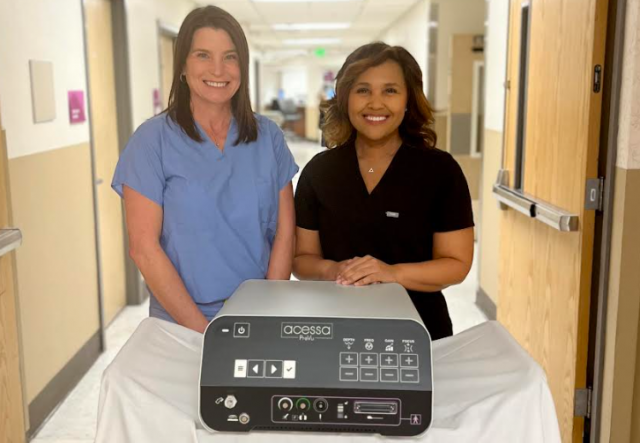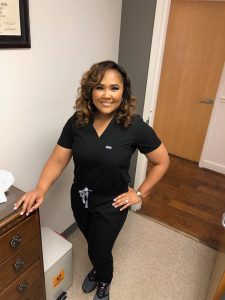
By Je’Don Holloway-Talley
For The Birmingham Times
More women dealing with fibroids are discovering a procedure that is minimally invasive, can be done in one day, and may reduce symptoms. Acessa, an outpatient therapy for fibroids, uses a technology called radiofrequency ablation.

Tomeka Roberts, M.D., a GYN with Ascension St. Vincent’s Women’s Health who completed the first Acessa procedure in Birmingham last year, said the procedure continues to gain traction because women are in search of treatment options that will enable them to preserve their uterus and fertility.
Uterine fibroids are muscular tumors that grow in or outside the wall of the uterus, or womb. They trouble up to 80 percent of women in the U.S., and eight out of 10 African American women are said to account for those statistics. The U.S. Department of Health and Human Services Office on Women’s Health (OWH) has said all women of childbearing age are at risk for fibroids, which are more commonly found in women ages 30 and up.
Roberts said, “Patients are doing research, Googling, and taking control [to learn about different fibroid treatment options]. I absolutely love that because they’re wanting to keep their uterus these days, so they’re doing their own research on ways to [not only preserve it] but also help treat their symptoms.”
Describing Acessa, Roberts said, “[This procedure] treats fibroids and spares the uterus. … [It] is good for people who don’t want major surgery. With other fibroid removal procedures like a myomectomy, [an operation to remove fibroids while preserving the uterus], the patient could be out of [work or off their feet] for six to eight weeks depending on which way the fibroids are removed.”
Acessa, on the other hand, doesn’t require much recovery time.
“[It] is a minimally invasive procedure, which means [patients] can typically go home the same day and be off their feet for a short amount of time with less blood loss,” Roberts said.
How it Works
How does radiofrequency ablation technology work?
Radiofrequency ablation uses radiofrequency energy, or heat, to cause coagulative necrosis (a type of cell death that occurs when blood flow to cells stops or slows) of fibroid tissue.
“The technology basically zaps the water from the cell, to say it simply, and the cell is destroyed,” Roberts explained.
The Acessa procedure requires only two small points of incision.
“One incision is more like a poke the size of a needle. We don’t even have to put a stitch on it. … [That incision is used to insert] the handpiece, [which is] the device that does the radio frequencies. The other [incision is used to insert] the camera that is used to see during the procedure. … Under ultrasound guidance, we are able to locate each fibroid and [apply the radio frequencies] to each fibroid,” the GYN said.
Options
Women have several options when it comes to fibroid treatment, including hysterectomy, the partial or total surgical removal of the uterus, Roberts said.
Laparoscopic myomectomy, according to the Mayo Clinic (mayocinic.org), is a procedure that involves the surgeon making a small incision in or near the bellybutton. He or she inserts a laparoscope, a narrow tube fitted with a camera, into the abdomen. The surgeon then performs the surgery with instruments inserted through other small incisions in the abdominal wall.
Another option is “a hysteroscopic myomectomy, [a procedure in which the surgeon] goes through the vagina and through the cervix to get to fibroids in the cavity of the uterus,” Roberts said. “[The surgeon] can get certain fibroids out that way, but they are not able to reach the ones that are in the muscle of the uterus or on top of the uterus.”
“Sometimes, I’ll actually do a combination of procedures,” she added. “I’ll do a laparoscopic procedure to get the [fibroids] on the outside, and then I’ll go below and do [a hysteroscopic myomectomy] to get the ones on the inside.”
This is where Acessa comes in—because it gives women a choice.
“With medicine, you always want to have a choice,” the GYN said. “Everyone is so different with how they feel about their bodies or what they want to have done to them. Some patients want medication only, some patients don’t want anything, and some want the most minimally invasive procedure they can have. Acessa just puts another option on the table.”
Education
Asked about a stigma surrounding fibroids, Roberts said, “Sometimes when I [diagnose] a patient with fibroids, they’ll start crying. I’ll tell them, ‘No, I’m not telling you that you have cancer. Let’s talk about the different options, which also include not having to do anything at all, [depending on the type of fibroids and symptoms experienced].’”
Roberts wants to educate women about the potential of fibroid development.
“I hear people say, ‘My mom had a hysterectomy, and my sister had a hysterectomy, so [that’s my fate].’ … That’s not correct because we have so many new things to treat fibroids now,” she said. “Just because your mom had fibroids and a hysterectomy doesn’t mean you are destined to have one.”
Early indicators of fibroid development can first present through changes in a woman’s body and cycle.
“[Women should be examined if they notice] changes with their cycle, such as painful or heavy cycles. … We define a heavy cycle as one that lasts five days or more and for which you need to change your pad more than every two hours,” Roberts said.
Other symptoms women should be mindful of include bloating, constipation, severe anemia, back and pelvic pain, fatigue, and dizziness.
Roberts believes women should start learning about their menstrual cycles, fibroids, and reproductive health during adolescence.
“That’s a good time to start talking about your cycle and family history. [Many women] start seeing me before they head to college, and over time you build trust with the 17- and 18-year-olds.”
Roberts educates women not only through her practice but also through Not On Our Watch (NOOW), her Birmingham-based nonprofit foundation that is dedicated to teaching young ladies about their bodies. The organization will host an event for adolescent girls at Jackson Olin High School on Saturday, March 18, from 10 a.m. to noon.
For more information about Acessa and other women’s health concerns, visit TomekaRobertsMD.com.



